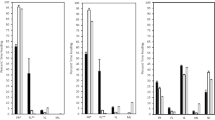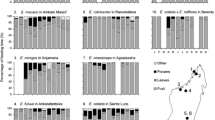Abstract
I studied the diets of two sympatric species ofEulemur (E. fulvus rufus andE. rubriventer) in the Ranomafana National Part in southeastern Madagascar from July 1988 through August 1989. Both species were highly frugivorous throughout the year and devoted similar amounts of time to feeding daily; the composition of their diets were similar. Three aspects of both lemur species' diets were correlated with seasonal food availability: changes in interspecific dietary overlap, the length of feeding bouts, and the amount of time devoted to feeding daily. Throughout the year neither species had a more diverse or more folivorous diet than its sympatric congener. However, there were several consistent year-round differences between their diets.E. f. rufus initiated more feeding bouts daily that were shorter in duration than those ofE. rubriventer. E. f. rufus also consistently exploited more unripe fruits and mature leaves thanE. rubriventer did throughout the study.E. f. rufus migrated from the study site during a period of fruit scarcity. These dietary patterns are discussed here in regard to feeding patterns observed in other sympatric congeneric primate species, whether these dietary differences can contribute to these two species' ability to coexist, and how differences in diet may be influenced by differences in social structure. I suggest that subtle, consistent differences in diet and seasonal dietary differences are sufficient to allow these two species to coexist.
Similar content being viewed by others
References
Altmann, J. (1974). Observational study of behavior.Behavior 49: 227–265.
Chapman, C. A. (1987). Flexibility in diets of three species of neotropical species of Costa Rican primates.Folia Primatol. 49: 90–115.
Chapman, C. A. (1990). Ecological constraints on group size in three species of neotropical primates.Folia Primatol. 55: 1–9.
Cords, M. (1986). Forest guenons and patas monkeys: male-male competition in one-male groups. In Smuts, B. B., Cheney, D. L., Seyfarth, R. M., Wrangham, R. W. and Struhsaker, T. T. (eds.),Primate Societies, University of Chicago Press, Chicago, pp. 94–111.
Crockett, C. M., and Wilson, W. L. (1980). The ecological separation ofMacaca nemestrina andM. fasicularis in Sumatra. In Lindburg, D. (ed.),The Macaques, Studies in Ecology, Behavior, and Evolution, Van Nostrand Rheinhold, New York, pp. 148–181.
Dunbar, R. I. M. (1988).Primate Social Systems, Cornell University Press, New York.
Ganzhorn, J. U. (1988). Food partitioning among Malagasy primates.Oecologia 75: 436–450.
Ganzhorn, J. U. (1989). Primate species separation in relation to secondary compounds.J. Hum. Evol. 4(2): 125–132.
Gautier-Hion, A. (1980). Seasonal variations of diet related to species and sex in a community ofCercopithecus monkeys.J. Anim. Ecol. 49: 237–269.
Gautier-Hion, A. (1989). Are figs always keystone resources for tropical frugivores vertebrates? A test in Gabon.Ecology 70(6): 1826–1833.
Gautier-Hion, A., and Gautier, J.-P. (1979). Niche ecologique et diversite des especes sympatrique dans le genre.Cercopithecus. Terre Vie Rev. Ecol. 33: 493–507.
Gautier-Hion, A., Bourliere, F., Gautier, J.-P., and Kingdon, J. (1988).A Primate Radiation: Evolutionary Biology of the African Guenons, Cambridge University Press, Cambridge.
Gittens, S. P., and Raemaekers, J. J. (1984). Siamang, lar, and agile gibbons. In Chivers, D. J. (ed.),Malayan Forest Primates: Ten Years Study in Tropical Rainforest, Plenum Press, New York, pp. 63–105.
Glander, K. E., Freed, B. Z., and Ganzhorn, J. U. (1985). Meat eating and predation in captive-born semi-free rangingLemur fulvus and cagedLemur macaco.Zoo Biol. 4: 362–365.
Glander, K. E., Wright, P. C., Daniels, P. S., and Merelender, A. M. (1992). Morphometrics and testicle size of rainforest lemur species from southeastern Madagascar.J. Hum. Evol. 22: 1–17.
Harcourt, C. (1986). Seasonal variation in the diet of South African galagos.Int. J. Primatol. 7(5): 491–506.
Hill, W. C. O. (1953).Primates Comparative Anatomy and Taxonomy I. Strepsirhini, University Press, Edinburgh.
Hladik, C. M. (1975). Ecology, diet, and social patterns in Old World and New World primates. In Tuttle, R. H. (ed.),Socioecology and Psychology of Primate, Mouton, The Hague, pp. 2–35.
Hladik, A. (1980). The dry forest of the west coast of Madagascar: Climate, phenology, and food available for Prosimians. In Charles-Dominique, P., Cooper, H. M., Hladik, A., Hladik, C. M., Pages, E., Pariente, G. F., Petter-Rousseaux, A., Schilling, A., and Petter, J. J. (eds.),Nocturnal Malagasy Primates: Ecology, Physiology, and Behavior, Academic Press, New York, pp. 1–40.
Hladik, C. M. (1988). Seasonal variations in food supply for wild primates. In Garine, I., and Harrison, G. A. (eds.),Coping with Uncertainty in Food Supply, Clarendon Press, Oxford, pp. 1–25.
Hladik, C. M., Charles-Dominique, P., and Petter, J. J. (1980). Feeding strategies of five nocturnal prosimians in the dry forest of the west coast of Madagascar. In Charles-Dominique, P. (ed.),Nocturnal Malagasy Primates, Academic Press, New York, pp. 41–74.
Janson, C. H. (1986). The mating system and a determinant of social evolution in Capuchin monkeys (Cebus). In Lee, P. C., and Else, J. G. (eds.),Primate Ecology and Conservation Vol. 2, Cambridge University Press, Cambridge, pp. 169–179.
Janson, C. H. (1988). Food competition in brown capuchin monkeys (Cebus apella): Quantitative effects of group size and tree productivity.Behaviour 105: 53–76.
Kay, R. F. (1975). The functional adaptations on primate molar teeth.Am. J. Primatol. 43(2): 195–215.
Kavanagh, M. (1978). The diet and feeding behavior of Cercopithecus aethiops.Folia Primatol. 30: 30–63.
Leighton, M., and Leighton, D. R. (1981). Vertebrate responses to fruiting seasonality within a Bornean rain forest. In Whitmore, T. C., and Chadwick, A. C. (eds.),Tropical Rain Forest Ecology and Management, Blackwell Scientific, Oxford, pp. 181–196.
Meyers, D. M. (1988). Behavior and ecology ofLemur fulvus rufus in southeastern Madagascar.Am. J. Phys. Anthropol. 75: 250.
Myers, D. M. (1992). Seasonal and habitat related variation in ranging behavior in the golden crowned sifaka (Propithecus tattersalli).Am. J. Phys. Anthropol. Suppl. 14: 122.
Morland, H. S. (1991).Social Organization and Ecology of Black-and-White Ruffed Lemurs (Varecia variegata variegata)in Lowland Rain Forest, Nosy Mangabe Island, Madagascar, Ph.D. thesis, Yale University, New Haven, CT.
Oates, J. (1977). The guerza and its food. In Clutton-Brock, T. (ed.),Primate Ecology: Studies of Feeding and Ranging Behavior in Lemurs, Monkeys, Apes, Academic Press, London.
Overdorff, D. J. (1991).Ecological Correlates of Social Structure in Two Prosimian Primates: Eulemur fulvus rufusand Eulemur rubriventer in Madagascar, Ph.D. thesis, Duke University, Durham, NC.
Overdorff, D. J. (1992). Differential patterns in flower feeding inEulemur fulvus rufus and Eulemur rubriventer in Madagascar.Am. J. Primatol. 28: 191–203.
Pollock, J. (1975).The Social Behavior of the Indri indri, Ph.D. thesis, London University, London.
Pollock, J. (1977). The ecology and sociology of feeding in Indri indri. In Clutton-Brock, T. (ed.),Primate Ecology: Studies of Feeding and Ranging Behavior in Lemurs, Monkeys, Apes, Academic Press, London, pp. 37–69.
Raemaekers, J. J. (1978). The sharing of food sources between two gibbon species in the wild.Malay. Nature J. 31: 181–188.
Richard, A. (1985).Primates in Nature, W. H. Freeman, New York.
Schoener, T. W. (1974). Resource partitioning in ecological communities.Science 185:27–29.
Shedd, D. H. (1990). Avian nest predation by a semi-captive collared lemur (Lemur fulvus collaris).Primates 31: 607–609.
Stacey, P. B. (1986). Group size and foraging efficiency in yellow baboons.Behav. Ecol. Sociobiol. 18: 175–187.
Struhsaker, T. T. (1975).The Red Colobus Monkey, University of Chicago Press, Chicago.
Struhsaker, T. T., and Oates, J. F. (1975). Comparison of the behavior and ecology of red colobus and black-and-white colobus monkeys in Uganda: A summary. In Tuttle, R. H. (ed.),Socioecology and Psychology of Primate, Mouton, The Hague, pp. 103–123.
Sussman, R. W. (1972).An Ecological Study of Two Malagasy Primates: Lemur fulvus rufusand Lemur cattaLinnaues, Ph.D., Duke University, Durham, NC.
Sussman, R. W. (1974). Ecological distinctions of sympatric species of Lemur. In Martin, R. D., Doyle, G. A., and Walker, A. C. (eds.),Prosimian Biology, Duckworth, London.
Tattersall, I. (1982).The Primates of Madagascar, Columbia University Press, New York.
Terborgh, J. (1983).Five New World Primates: A Study in Comparative Ecology, Princeton University Press, Princeton, NJ.
Terborgh, J. (1986). Keystone plane resources in the tropical forest. In Soule, M. (ed.),Conservation Biology: The Science of Scarcity and Diversity, Sinauer Associates, Sunderland, MA, pp. 330–344.
Terborgh, J., and Janson, C. H. (1986). The sociecology of primate groups.Rev. Ecol. Syst. 17: 111–135.
Watts, D. (1985). Relations between group size and group composition and feeding competition in mountain gorilla groups.Anim. Behav. 33: 72–85.
van Schaik, C. P., and van Noordwijk, M. A. (1988). Scramble and contest in feeding competition among female long-tailed macaques (Macaca fasicularis).Behaviour 105:77–98.
van Schaik, C. P., van Noorwijk, M. A., de Boer, R. J., and Tonkelaar, I. (1983). The effect of group size on time budgets and social behavior in wild lion-tailed macaques (Macaca fasicularis).Behav. Eco. Syst. 13: 173–181.
White, F. J., and Wrangham, R. W. (1988). Feeding competition and patch size in the chimpanzee species:Pan paniscus andPan troglodytes.Behaviour 105: 148–164.
Whitten, P. L. (1988). Effects of patch size and feeding subgroup size on feeding success in vervet monkeys (Cercopithecus aethiops).Behaviour 105: 35–52.
Wright, P. C. (1986). Ecological correlates to monogamy. In Else, J. G., and Lee, P. C. (eds.),Primate Ecology and Conservation, Cambridge, Cambridge University Press, pp. 159–168.
Wright, P. C. (1987). Diet and ranging patterns ofPropithecus diadema edwardsi in Madagascar.Am. J. Phys. Anthropol. 72(2): 271.
Wright, P. C. (1992). Demographic changes in ranging patterns inPropithecus diadema edwardsi in Madagascar.Am. J. Phys. Anthropol. Suppl. 14: 177.
Yeager, C. (1989). Feeding ecology of the proboscis monkey (Nasalis larvatus).Int. J. Primatol. 10: 497–530.
Author information
Authors and Affiliations
Rights and permissions
About this article
Cite this article
Overdorff, D.J. Similarities, differences, and seasonal patterns in the diets ofEulemur rubriventer andEulemur fulvus rufus in the Ranomafana National Park, Madagascar. International Journal of Primatology 14, 721–753 (1993). https://doi.org/10.1007/BF02192188
Issue Date:
DOI: https://doi.org/10.1007/BF02192188




